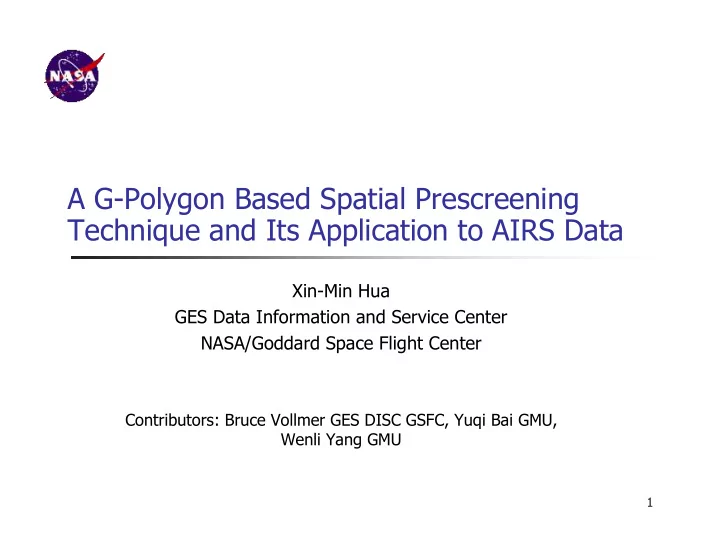

A G-Polygon Based Spatial Prescreening Technique and Its Application to AIRS Data Xin-Min Hua GES Data Information and Service Center NASA/Goddard Space Flight Center Contributors: Bruce Vollmer GES DISC GSFC, Yuqi Bai GMU, Wenli Yang GMU 1
Introduction Why prescreening? G-polygon vs bounding box An accurate prescreening technique Its applications to AIRS data The technique is described in A Spatial Pre-Screening Technique for Earth Observation Data, IEEE Geoscience and Remote Sensing Letters, Vol. 4, No. 1, January 2007 by Xin-Min Hua, Jianfu Pan, Dimitar Ouzounov, Alecei Lyapustin, Yujie Wang, Krishna Tewari, Gregory Leptoukh and Bruce Vollmer, 2
Why prescreening? EOS instruments (MODIS, AIRS ……) provide data granules covering large spatial areas, on the order of 1000 km. Many researches (e.g. comparative studies, validation by ground observations ……) focus on regional processes, requiring much less than full granules. Researchers want to know in advance if a given data granule covers the locations of interest to them. 3
An example: AERONET stations 4
Options No pre-screening: pixel-by-pixel comparison – slow. Bounding box (Max./Min. lat/lon) – inaccurate, needs special treatment for high-latitude and dateline/pole crossing granules. An accurate prescreening algorithm, capable of handling all data granules uniformly, regardless of their locations on the Earth, with no special treatment required for dateline/pole crossing granules. – Too good to be possible? 5
G-polygon vs Bounding box Example 1: Bounding box at low latitudes 6
Example 2: Bounding box at high latitudes – crossing pole, dateline 7
An accurate prescreening technique Definitions and Assumptions: Earth surface can be approximated by a sphere. An AIRS/MODIS granule (6/5 minutes) covers a rectangular region (swath) on the surface of Earth – approximated by 4-sided G-polygon. G-polygon -- polygon on a sphere with arcs of great circles as its edges. G-polygon divides the sphere into two domains – interior and exterior. Define the order of vertices of a G-polygon (G-Ring sequence) as follows: when one moves in the order along the boundaries, interior is always on the right-hand-side. 8
G-polygon: interior and exterior Vertices order (G-ring v 3 sequence): 1-2-3-4-1 v 4 Clockwise ! interior v 2 v 1 9
Great circle equation longitude, latutude � � � � Great circle equation passing through point p ( , ) and p ( , ) � � � � 1 1 1 2 2 2 with a direction from p to p : 1 2 f ( , ) tan sin( ) tan sin( ) tan sin( ) 0 . � � = � � � � + � � � � + � � � � = 1 2 1 2 2 1 Great circle divides sphere into three domains : On great circle : f ( , ) 0 � � = On right - hand - side : f ( , ) 0 ; � � > On left - hand - side : f ( , ) 0 . � � < 10
Criterion for G-polygon interior A swath with 4 corners : v ( , ), v ( , ), � � � � 1 1 1 2 2 2 v ( , ), v ( , ). � � � � 3 3 3 4 4 4 v 3 v 4 Edges of the swath : f ( , ) 0 , ( i 1 , 2 , 3 , 4 ) � � = = i with (v , v ), (v , v ), 1 2 2 3 (v , v ), (v , v ) v 2 3 4 4 1 replacing ( p , p ). 1 2 v 1 A point ( , ) is inside swath � � if f ( , ) 0 for i 1,2,3,4 � � > = i 11
Application to AIRS data Subsetting AIRVBRAD data for 36 sites in Coordinated Enhanced Observing Period Data Management (CEOP) Site Lon Lat ------------------------- RON -61.93 -10.08 BRA -47.92 -15.93 PAN -57.01 -19.56 12
AIRS geolocation information v2 v3 Along track 134 AIRVBRAD data Geolocation information: Longitude, Latitude 135 X 90 (=12150) Scan line number Vertices sequence: Vertex 2-dim 1-dim ------------------------------------- V1 [0,0] [0] V2 [134, 0] [12060] Cross track V3 [134, 89] [12149] V4 [0, 89] [89] 2 1 v4 0 v1 89 0 13
Performance CEOP AIRVBRAD subsetter using G-polygon based prescreening Test on 406 granules of 2007.08.20, 21, 22 Before -- Use bounding rectangle plus special treatments for dateline/pole crossing granules. Sometimes need to scan all pixels. Found 130 sites covered. After – Only need to know lat/lon values of the 4 corners and blindly apply the technique. Treat all ground sites and granules equally. Found 131 sites covered. 14
Performance - accuracy Before – false negative (all marginal): 2007.08.20 #181 PAN 2007.08.21 #074 EIS 2007.08.22 #119 NSA false positive: 2007.08.21 #160 ES1 2007.08.21 #193 ES1 After -- No false positive, no false negative. 15
Performance - efficiency CEOP AIRVBRAD subsetter using G-polygon based prescreening Test on 406 granules of 2007.08.20, 21, 22 checkSitePos -- function checking if a granule covers any sites Time profiling results: Before -- Computer time: 0.36 sec. 0.17 ms/call After – Computer time: 0.03 sec. 0.01 ms/call Over 10 times faster! 16
Conclusion Accurate, reliable and efficient pre-screening method. Treats all granules, ground sites equally. Cab be applied blindly as long as 4 corners are in clockwise order. Boundaries can be expanded or shrunk to meet users’ special requirement on marginal sites. (see the paper) Recommended for Matchup PGEs, V6 planning. 17
Recommend
More recommend